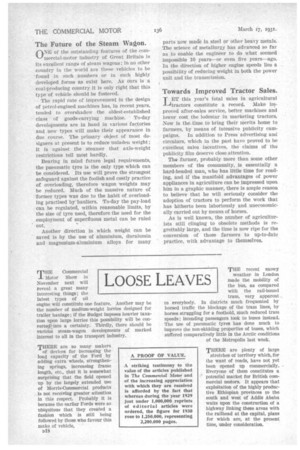Municipal Reliance on Motors
Page 79

Page 80

If you've noticed an error in this article please click here to report it so we can fix it.
THE past year has been one of steadily extending activities in the motorization of the many branches of municipal work. The progress made is, perhaps, not spectacular, but it is none the less of the greatest importance, as upon it depends, to a very large extent, the essential requirements of the community in the way of transport facilities, health and comfort. We must also not forget that important factor of improved safety in the event of 'fire, whilst increasing efficiency is being attained, in connection with the smooth and rapid transport of the sick and injured —in fact, it is difficult to pick out any sphere of Municipal enterprise in which the motor vehicle or appliance is not, in some way, exercising its beneficial influence.
Passenger transport is, perhaps, the most striking example. That obsolescent vehicle, the tram, is being steadily pushed into the background by the bus and the trolley-bus. Lines are being torn up in many districts, but where the rival services are operated together, it is notable that the public expresses a determined preference for the -more mobile methods of transport, even if it has to pay more on this account.
We publish elsewhere in this issue a remarkable record of the ;past year's progress in the provision of municipal passengertransport facilities, which indicates that the number of vehicles in service is increasing by over 1,000 per year, whilst the number of passengers carried rose by over 300,000,000, representing approximately 60 per cent., above the total for the previous year.
Many' municipalities are carrying out trials of oilengined vehicles, and this type of machine—if it fulfils all that is hoped for it—will alone be a powerful agent in expediting the change-over which is occur ring.
In connection with the collection of household refuse, matters are in something of a state of flux. Important:-experiments are being carried out with systems by which bins are conveyed -to and from the tips or destructors.
It is as yet too early to say how this tendency will develop, but, in any case, it is satisfactory to note that efforts are being made on all sides to render more hygienic the methods of collection and disposal; by pro-. viding covers in sections which can be opened without difficulty by the loader's foot, the weight of the bin, or a combination of the two, the arrangement being usually such that the contents of the bin can be shot into the interior with but little exposure to the open air.
There are, in addition, systems in which the• contents of the bin are practically sealed during discharge.
The Future of the Steam Wagon.
ONE of the outstanding features of the coinmercial-motor industry of Great Britain is its excellent range of steam wagons; in no other country in the world are these vehicles to be found in such numbers or ia such highly developed forms as exist here. As ours is a coal-producing country it is only right that this type of vehicle should be fostered.
The rapid rate of improvement in the design of petrol-engined machines has, in recent years, tended to overshadow the oldest-established class of goods-carrying Machine. To-day developments are in hand in various factories and new types will make their appearance in due course. The primary object of most designers at present is to reduce unladen weight ; It is against the steamer that axle-weight restrictions tell most hardly.
Bearing in mind future legal requirements, the pneumatic tyre is the only type which can be considered. Its use will prove the strongest safeguard against the foolish and costly practice of overloading, therefore wagon weights may be reduced. Much of the massive nature of former types was due to the habit of overloading practised by hauliers. To-day the pay-load can be regulated, within reasonable limits, by the size of tyre used, therefore the need for the _employment of superfluous metal can be ruled out.
Another direction in which weight can be saved is by the use of aluminium, duralumin and magnesium-aluminium alloys for many parts DOW made in steel Or other heavy metals. The science of metallurgy has advanced so far as to enable the engineer to do what seemed Impossible 10 years—or even live years—ago. In the direction of higher engine speeds lies a Possibility of reducing weight in both the power unit and the transteission.
Towards Improved Tractor Sales.
T E-T this year's total sales in agricultural -11-tractors constitute a record. Make improved after-sales service, better machines and lower cost the lodestar in marketing tractors.• Now is the.time, to bring their merits home to farmers, by means of intensive publicity campaigns. In addition to Press advertising and circulars, which in the past have proved to be excellent sales incentives, the claims of the Publicity film de-serve close attention.
Tho farmer, probably more than some other members of the community, is essentially a hard-headed man, who has little time for reading, and if the manifold advantages of power appliances in agriculture can be impressed upon him in a graphic manner, there is ample reason to believe that he will seriously consider the adoption of tractors to perform the work that has hitherto been laboriously and uneconomically carried out by means of horses.
As is well known, the number of agriculturists still clinging to obsolete methods is regrettably large, and the time is now ripe for the conversion of those farmers to up-to-date practice, with advantage to themselves.
























































































































































































